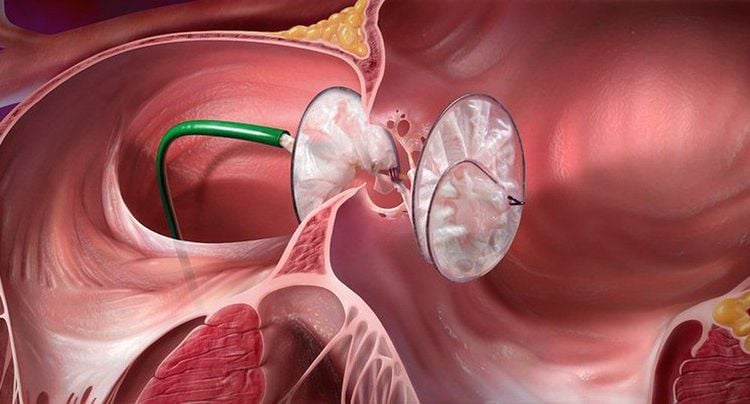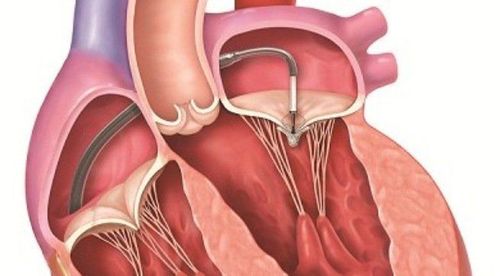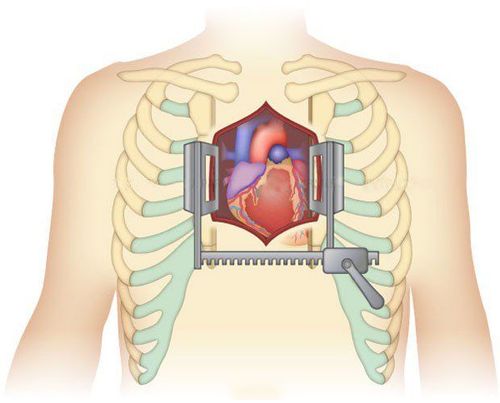This is an automatically translated article.
The article was professionally consulted by Professor, Doctor, Doctor Vo Thanh Nhan, Cardiology Center - Vinmec Central Park International General HospitalCardiovascular interventional techniques through catheters have a history of development more than 40 years. Recent studies have shown that this method has many outstanding advantages over traditional open surgery and can be performed routinely for some heart diseases, especially intervention to close the atrial septal defect. .
1. What is atrial septal defect closure?
Atrial septal defect is a common congenital heart disease, accounting for 5-10% of congenital heart defects in children, in adults this rate is 30%, accounting for about 0.01% of the total population.Cardiovascular catheterization technique is a minimally invasive treatment method, with access usually through the femoral vein without opening the chest. Thereby, interventional instruments are inserted into the heart through catheters, to block the atrial septal defect.
2. Designated object
Atrial septal defect is secondary and the orifice size is not too large (≤ 34 mm, measured on echocardiography). There is a sufficiently wide periventricular margin (atrioventricular valve, right pulmonary vein, aortic ridge, superior and inferior venous ridge): ≥ 5 mm Large shunt causing hemodynamic compromise Patient has signs of occlusion Paradoxical is also indicated for occlusion, even if the shunt is small.. Contraindications: Interventional techniques in the treatment of atrial septal defect are contraindicated in the following cases:Cases with primary atrial septal defect. , venous sinus hole Subjects with atrial septal defect are in complex congenital heart disease Patients with severe coagulopathy Patients with severe medical and surgical diseases unable to undergo interventional cardiac catheterization
3. Technical implementation process

Screening steps include: Diagnostic imaging: transthoracic echocardiography and transesophageal echocardiography, upright chest X-ray, Electrocardiogram, Hematology and blood biochemistry, Pre-intervention with Antiplatelet drugs Procedures: Sterilize, local anesthetic the puncture area Insert the catheter from the femoral vein into the inferior vena cava, to the right atrium, through the left atrial septal defect into the pulmonary vein; Use a balloon to measure the diameter of the atrial septal defect; The size of the septal defect occlusion device is usually 2-4 mm larger than the balloon's waist circumference. Insert the device into the cabling system. The instrument is then inserted into the catheter system, slowly pushing the instrument toward the ASD to release the occlusion. Combined with extrathoracic or esophageal ultrasound to check, if the instrument is in the correct position and does not compress the surrounding structure, release the instrument.
4. Advantages of the technique
The method is safe and does not require a lot of technical means, and can be routinely deployed in facilities with cardiac catheterization rooms.The method is more esthetic than the traditional open method with the classic midsternal longitudinal incision
Reduced trauma, less pain, less bleeding
The patient is fully awake during the procedure, and the process is complete. The recovery process, hospital stays are significantly reduced
The rate of surgical site infections is reduced
5. Abnormal manifestations after performing the technique
Embolism due to air or thrombosis Pericardial effusion: due to perforation, atrial wall tear, atrial appendage Displacement, fall of umbrella from position Other abnormalities: swelling, bleeding at the puncture site, infection...6. Follow-up after surgery
The patient stayed at the hospital 48 hours after the intervention, was monitored:Regular health status, as directed by the doctor Ultrasound, post-procedural tests Post-discharge follow-up:
Post-discharge follow-up 07 daily, 30 days and periodically by appointment; Drug treatment: use antiplatelet drugs for 6 months; and discontinue the drug when there is no residual stoma

7. Where is the closure of the atrial septal defect?
Currently, all Vinmec International General Hospitals nationwide can perform the closure of the atrial septal defect by percutaneous intervention with a methodical and strict procedure, ensuring safety, accuracy and precision. provide high treatment efficiency.Vinmec with advanced equipment and a team of experienced and well-trained doctors and nurses, professional and dedicated patient care services will help patients have the most comfortable experience when operating. Minimally invasive open heart here.
In April & May 2021, when there is a need for medical examination and treatment at Vinmec Times City International General Hospital, customers will enjoy dual incentives:
- Free specialist examination and discount 50% of many cardiac checkup packages such as:
+ Basic Cardiovascular Screening Package
+ Hypertension Checkup Package
+ Heart Failure Checkup Package
+ Coronary Cardiovascular Examination Package
+ Comprehensive Cardiovascular Checkup Package
- 50 off % of cost for customers with post-examination treatment indications. The program is limited to the corresponding technique of each hospital and to customers who perform this treatment technique for the first time at Vinmec.
Please dial HOTLINE for more information or register for an appointment HERE. Download MyVinmec app to make appointments faster and to manage your bookings easily.














